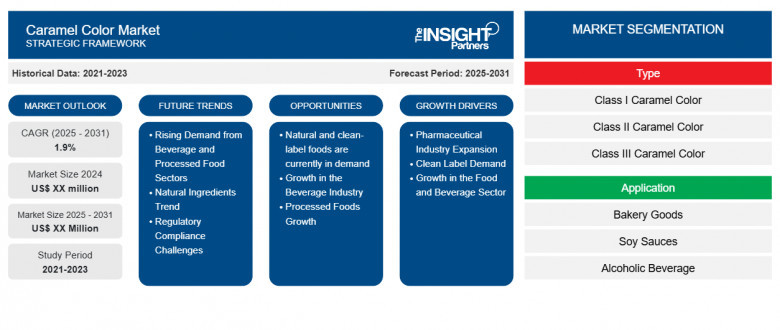views
Food and Beverages

Caramel color is one of the most widely used food colorants globally. Found in everything from colas and sauces to baked goods and pet foods, caramel color plays a vital role in enhancing product appearance and consumer appeal. As demand rises for processed, packaged, and ready-to-eat foods, the caramel color market continues to grow, driven by evolving consumer preferences, clean-label trends, and expanding food & beverage industries.
Get Free Sample For Caramel Color Market: https://www.theinsightpartners.com/sample/TIPRE00013085
What is Caramel Color?
Caramel color is a water-soluble food coloring made by carefully heating carbohydrates like glucose, sucrose, or fructose often in the presence of acids, alkalis, or salts. It imparts rich hues ranging from light yellow to dark brown, depending on its class and application.
There are four primary classes of caramel color:
- Class I (Plain Caramel) – No ammonium or sulfite compounds; used in natural or organic foods.
- Class II (Caustic Sulfite Caramel)
- Class III (Ammonia Caramel) – Common in baked goods and soy sauce.
- Class IV (Sulfite Ammonia Caramel) – Most used in soft drinks like colas.
Market Drivers
1. Booming Beverage Industry
Caramel color is indispensable in carbonated soft drinks, beers, spirits, and energy drinks. As global beverage consumption grows, particularly in Asia-Pacific and Latin America, so does the demand for consistent and appealing coloring agents.
2. Demand for Processed & Packaged Foods
Ready-to-eat meals, sauces, gravies, and canned foods rely on caramel color for visual appeal and product standardization, especially when ingredient variations affect color naturally.
3. Clean Label & Natural Trends
Manufacturers are increasingly seeking Class I caramel colors for clean-label product development. These variants appeal to consumers demanding minimally processed, recognizable ingredients.
4. Expansion of Foodservice Chains
The growth of QSRs (Quick Service Restaurants) and packaged foodservice offerings has amplified the demand for shelf-stable, attractive products, pushing the need for high-quality food colorants like caramel color.
Key Applications
- Beverages: Soft drinks, beer, whiskey, iced tea
- Bakery & Confectionery: Breads, cookies, chocolates
- Savory & Convenience Foods: Soups, sauces, gravies, instant meals
- Pet Foods: Appearance enhancement and consumer appeal
- Pharmaceuticals & Cosmetics: Used in cough syrups, tablets, and some personal care items
Market Segmentation
By Form:
- Liquid
- Powder
- Granules
By Class:
- Class I (Plain)
- Class II (Sulfite Process)
- Class III (Ammonia Process)
- Class IV (Sulfite-Ammonia Process)
By End Use:
- Food & Beverage
- Pharmaceuticals
- Cosmetics & Personal Care
- Pet Food
Regional Insights
- North America: A mature market led by demand for beverages and processed foods. Regulatory awareness and clean-label trends are driving Class I caramel color adoption.
- Europe: Strong demand in sauces, bakery, and confectionery segments; strict regulations fuel the shift to natural options.
- Asia-Pacific: Fastest-growing market due to the expanding F&B industry, urbanization, and increasing disposable incomes in countries like China and India.
- Latin America & Middle East: Emerging markets with increasing consumption of packaged foods and drinks.
Key Market Players
- DDW, The Color House (Givaudan)
- Sensient Technologies Corporation
- Kerry Group
- Sethness-Roquette
- Nigay SAS
- Asahi Group Foods
- Farbwerke Brillux
- Aarkay Food Products
These players focus on developing low-4-MEI variants, improving heat and acid stability, and expanding production capacities globally.
Challenges and Opportunities
Challenges:
- Health concerns regarding 4-Methylimidazole (4-MEI) in some caramel colors
- Competition from natural alternatives like annatto, beet juice, and turmeric
- Strict labeling and compliance requirements in Europe and North America
Opportunities:
- Growth of organic and natural food segments
- Rising popularity of plant-based beverages that require coloring adjustments
- Innovations in low-process and enzymatically-derived caramel colors
Future Outlook
The global caramel color market is expected to witness steady growth with a projected CAGR of 4–5% over the next five years. Rising demand from the beverage and convenience food sectors, along with innovations in clean-label formulations, will continue to drive market expansion.
Conclusion
Caramel color is more than just a food additive it’s a critical element in the visual identity and consumer perception of thousands of products worldwide. As the food industry shifts toward more natural and transparent ingredients, the caramel color market is evolving to meet both regulatory standards and consumer expectations.



Comments
0 comment